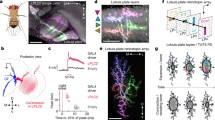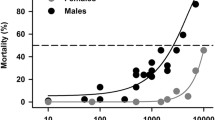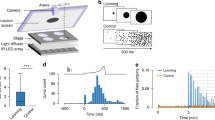Abstract
Many animals begin to escape by moving away from a threat the instant it is detected. However, the escape jumps of locusts take several hundred milliseconds to produce and the locust must therefore be prepared for escape before the jumping movement can be triggered. In this study we investigate a locust’s preparations to escape a looming stimulus and concurrent spiking activity in its pair of uniquely identifiable looming-detector neurons (the descending contralateral movement detectors; DCMDs). We find that hindleg flexion in preparation for a jump occurs at the same time as high frequency DCMD spikes. However, spikes in a DCMD are not necessary for triggering hindleg flexion, since this hindleg flexion still occurs when the connective containing a DCMD axon is severed or in response to stimuli that cause no high frequency DCMD spikes. Such severing of the connective containing a DCMD axon does, however, increase the variability in flexion timing. We therefore propose that the DCMD contributes to hindleg flexion in preparation for an escape jump, but that its activity affects only flexion timing and is not necessary for the occurrence of hindleg flexion.






Similar content being viewed by others
Abbreviations
- DCMD:
-
Descending contralateral movement detector
- FETi:
-
Fast extensor tibiae motor neuron
- EPSP:
-
Excitatory postsynaptic potential
- fps:
-
Frames per second
References
Bennet-Clark HC (1975) The energetics of the jump in the locust Schistocerca gregaria. J Exp Biol 63:53–83
Burrows M (1995) Motor patterns during kicking movements in the locust. J Comp Physiol A 176:289–305
Burrows M (1996) The neurobiology of an insect brain. Oxford University Press, Oxford
Burrows M, Morris G (2001) The kinematics and neural control of high-speed kicking movements in the locust. J Exp Biol 204:3471–3481
Burrows M, Rowell CHF (1973) Connections between descending visual interneurons and metathoracic motoneurons in the locust. J Comp Physiol A 85:221–234
Edwards DH, Heitler WJ, Krasne FB (1999) Fifty years of a command neuron: the neurobiology of escape behavior in the crayfish. Trends Neurosci 22:153–161
Fotowat H, Gabbiani F (2007) Relationship between the phases of sensory and motor activity during a looming-evoked multistage escape behavior. J Neurosci 27:10047–10059
Friedel T (1999) The vibrational startle response of the desert locust Schistocerca gregaria. J Exp Biol 202:2151–2159
Gabbiani F, Krapp HG, Koch C, Laurent G (2002) Multiplicative computation in a visual neuron sensitive to looming. Nature 420:320–324
Gabbiani F, Krapp HG, Laurent G (1999) Computation of object approach by a wide-field motion-sensitive neuron. J Neurosci 19:1122–1141
Gabbiani F, Mo C, Laurent G (2001) Invariance of angular threshold computation in a wide-field looming-sensitive neuron. J Neurosci 21:314–329
Gynther IC, Pearson KG (1986) Intracellular recordings from interneurones and motoneurones during bilateral kicks in the locust: implications for mechanisms controlling the jump. J Exp Biol 122:323–343
Hatsopoulos N, Gabbiani F, Laurent G (1995) Elementary computation of object approach by a wide-field visual neuron. Science 270:1000–1003
Heitler WJ (1974) The locust jump: specialisations of the metathoracic femoral–tibial joint. J Comp Physiol 89:93–104
Heitler WJ (1983) Suppression of a locust interneurone (DCMD) during defensive kicking. J Exp Biol 104:203–215
Heitler WJ, Burrows M (1977) The locust jump I: the motor programme. J Exp Biol 66:203–219
Korn H, Faber DS (2005) The mauthner cell half a century later: a neurobiological model for decision-making? Neuron 47:13–28
O’Shea M, Rowell CHF, Williams JLD (1974) The anatomy of a locust visual interneurone: the descending contralateral movement detector. J Exp Biol 60:1–12
Pearson KG, Goodman CS (1979) Correlation of variability in structure with variability in synaptic connections of an identified interneuron in locusts. J Comp Neurol 184:141–166
Pearson KG, Heitler WJ, Steeves JD (1980) Triggering of locust jump by multimodal inhibitory interneurons. J Neurophysiol 43:257–278
Pearson KG, Robertson RM (1981) Interneurons coactivating hindleg flexor and extensor motoneurons in the locust. J Comp Physiol A 144:391–400
Pflüger H-J, Burrows M (1978) Locusts use the same basic motor pattern in swimming as in jumping and kicking. J Exp Biol 75:81–93
Rind FC, Simmons PJ (1992) Orthopteran DCMD neuron: a reevaluation of responses to moving objects. I. selective responses to approaching objects. J Neurophysiol 68:1654–1666
Rogers SM, Krapp HG, Burrows M, Matheson T (2007) Compensatory plasticity at an identified synapse tunes a visuomotor pathway. J Neurosci 27:4621–4633
Ronacher B, Wolf H, Reichert H (1988) Locust flight behavior after hemisection of individual thoracic ganglia: evidence for hemiganglionic premotor centers. J Comp Physiol A 163:749–759
Rowell CHF (1971) The orthopteran descending movement detector (DMD) neurones: a characterisation and review. Z Vgl Physiol 73:167–194
Santer RD, Rind FC, Stafford R, Simmons PJ (2006) The role of an identified looming-sensitive neuron in triggering a flying locust’s escape. J Neurophysiol 95:3391
Santer RD, Simmons PJ, Rind FC (2005a) Gliding behaviour elicited by lateral looming stimuli in flying locusts. J Comp Physiol A 191:61–73
Santer RD, Yamawaki Y, Rind FC, Simmons PJ (2005b) Motor activity and trajectory control during escape jumping in the locust Locusta migratoria. J Comp Physiol A 191:965–975
Schlotterer GR (1977) Response of the locust descending movement detector neuron to rapidly approaching and withdrawing visual stimuli. Can J Zool 55:1372–1376
Steeves JD, Pearson KG (1982) Proprioceptive gating of inhibitory pathways to hind leg flexor motoneurons in the locust. J Comp Physiol A 146:507–515
Wheatstone C (1852) Contributions to the physiology of vision. II. Philos Trans R Soc Lond B 142:1–18
Acknowledgments
This work was funded by the BBSRC and EU. Experiments comply with the “Principles of animal care”, publication No. 86-23, revised 1985 of the National Institute of Health, and also with the current laws of the UK.
Author information
Authors and Affiliations
Corresponding author
Rights and permissions
About this article
Cite this article
Santer, R.D., Yamawaki, Y., Rind, F.C. et al. Preparing for escape: an examination of the role of the DCMD neuron in locust escape jumps. J Comp Physiol A 194, 69–77 (2008). https://doi.org/10.1007/s00359-007-0289-8
Received:
Revised:
Accepted:
Published:
Issue Date:
DOI: https://doi.org/10.1007/s00359-007-0289-8




